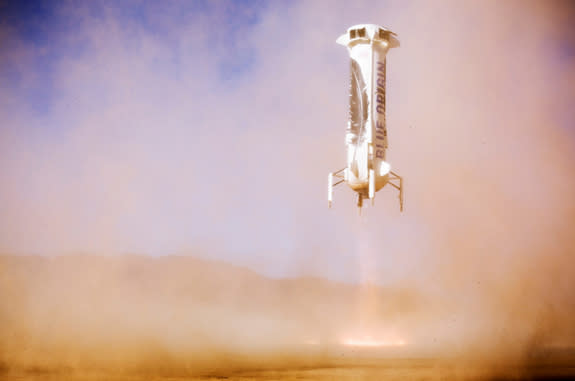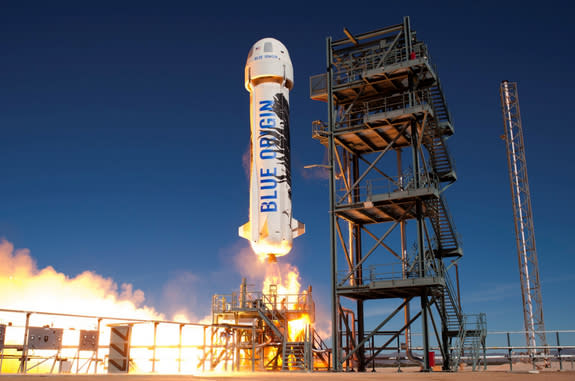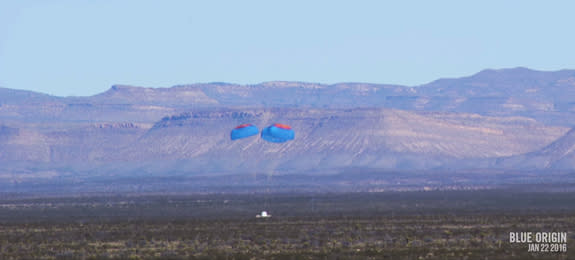Blue Origin Launches Rocket Into Space and Lands It Safely for 2nd Time
Blue Origin has done it again. The private spaceflight company has launched a private rocket into space and landed it back on Earth. And as a bonus, Blue Origin reused the same rocket from its first launch-landing test flight.
"Launch. Land. Repeat," company officials wrote in a statement announcing the epic space feat on Friday (Jan. 22). The statement accompanied a spectacular video of the Blue Origin launch and landing.
Blue Origin's billionaire founder Jeff Bezos announced the test flight success in a blog post, revealing that it used the same suborbital New Shepard rocket and crew capsule the company launched and landed last year. Both flights launched from and landed at the company's proving grounds in West Texas. [See more photos of Blue Origin's test flight]
"The very same New Shepard booster that flew above the Karman line and then landed vertically at its launch site last November has now flown and landed again, demonstrating reuse," Bezos wrote. The Karman Line is the widely recognized border between Earth and space, about 62 miles (100 kilometers) above the surface.
Blue Origin is one of several commercial spaceflight companies pursuing reusable rocket and spacecraft technology to dramatically lower the cost of space travel. In Blue Origin's case, the company aims to launch passengers into space on its New Shepard spacecraft, which will seat six people.
Blue Origin made history last year when its New Shepard booster launched into suborbital space and returned to Earth. That Nov. 23 test flight reached an altitude of 329,839 feet (62.4 miles or 100.5 km). The Jan. 22 flight went a bit higher, to 333,582 feet (63.2 miles or 101.7 km), "before both capsule and booster gently returned to Earth for recovery and reuse," Bezos wrote in the statement.
Blue Origin's New Shepard rocket and crew capsule are suborbital spacecraft, meaning that they can launch into space, but cannot orbit the Earth. The New Shepard booster is designed to launch and land vertically, while its crew capsule separates in space and returns to Earth to make a parachute landing.
Another private company, Blue Origin's rival SpaceX founded by Elon Musk, has successfully launched and landed its Falcon 9 rocket — which does fly all the way into orbit — in the pursuit of reusable rocket technology. SpaceX aims to launch, land and reuse a Falcon 9 booster sometime this year. The company already tried to land a Falcon 9 once this year during a Jan. 17 flight, but a landing leg failed to latch securely, causing the rocket to tip over and explode after touching down on a drone ship platform. (SpaceX did achieve a successful Falcon 9 touchdown on land in December.)
In his statement, Bezos wrote that there are some compelling reasons why Blue Origin is pursuing vertical launch and landings as its approach to reusable spaceflight systems.
"Though wings and parachutes have their adherents and their advantages, I'm a huge fan of rocket-powered vertical landing," Bezos wrote. "Why? Because — to achieve our vision of millions of people living and working in space — we will need to build very large rocket boosters. And the vertical landing architecture scales extraordinarily well."
According to Bezos, New Shepard may be the smallest rocket Blue Origin has flown, but it's the foundation for ever-larger and more capable reusable space vehicles. The company plans to launch and land New Shepard "again and again" this year while also beginning full-up testing of its new, more powerful BE-4 rocket engine. New Shepard uses a single BE-3 engine for launches and landings, Bezos added.
"We’re already more than three years into development of our first orbital vehicle," he wrote. "Though it will be the small vehicle in our orbital family, it’s still many times larger than New Shepard. I hope to share details about this first orbital vehicle this year."
Email Tariq Malik at tmalik@space.com or follow him @tariqjmalik and Google+. Follow us @Spacedotcom, Facebook and Google+. Original article on Space.com.
Copyright 2016 SPACE.com, a Purch company. All rights reserved. This material may not be published, broadcast, rewritten or redistributed.



